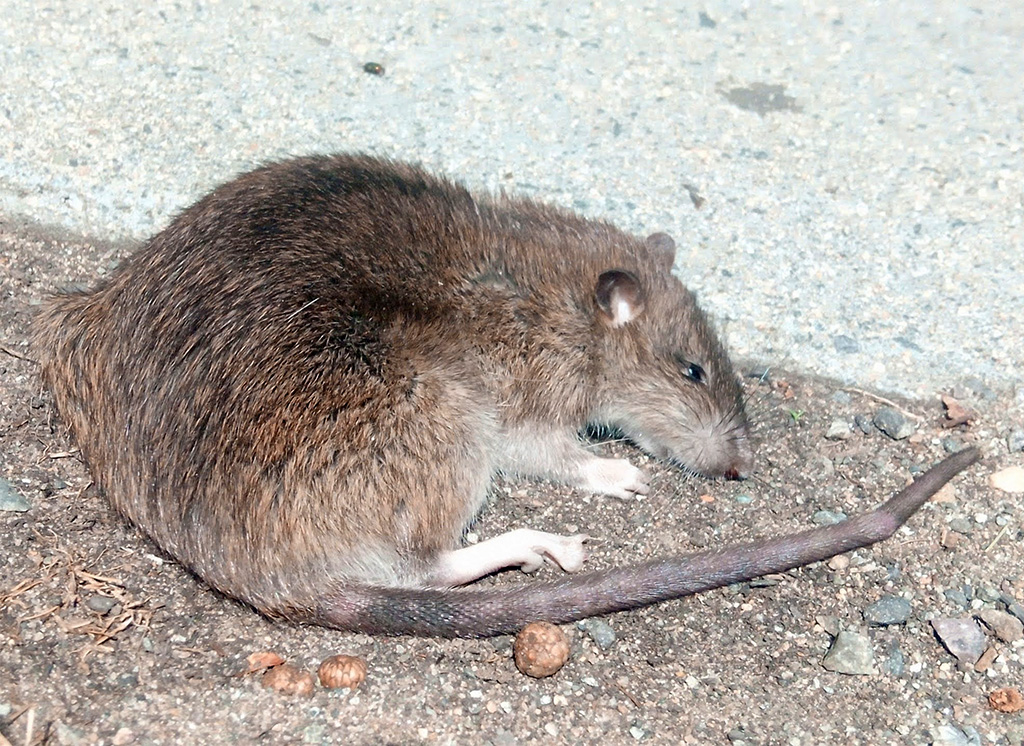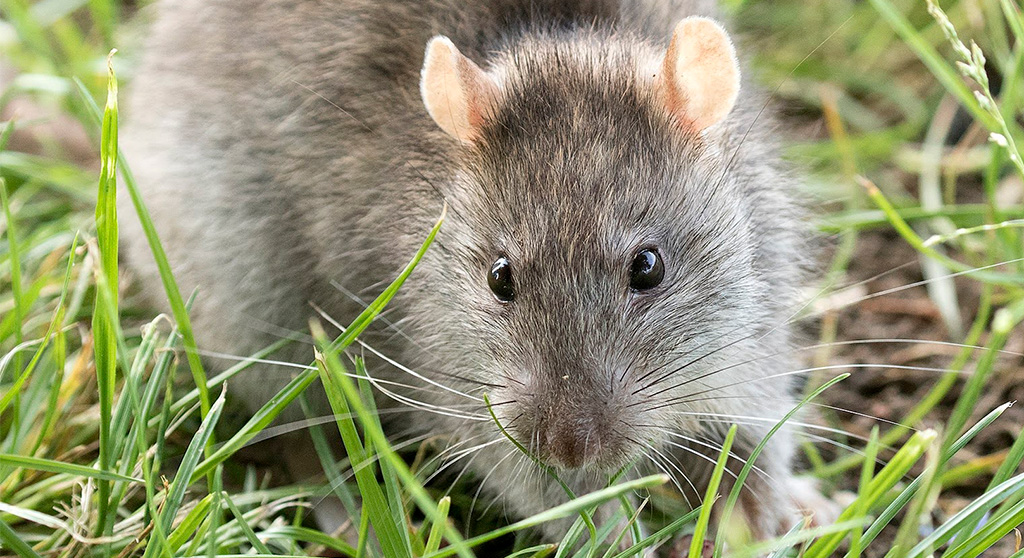Rats really are hard to kill – as a species, anyway, with an evolutionary fail-safe for rapid breeding

Brown rats have small ears, brown or grayish fur and black eyes. (Photo: Zeynel Cebeci via Wikimedia commons)
Rats! They are common in the city and the country and the suburbs. Wherever humans grow food or cook it, rats follow. The rats we encounter in Massachusetts are brown rats (Rattus norvegicus), also called sewer rats, wharf rats, street rats, Norway rats and so on, because they are found in all these places and more. As far as rats go, brown rats are one of the largest, up to 11 inches long. They are native to Mongolia and Northern China, but today they live everywhere except Antarctica, the arctic, a few islands and, since 1950, the Canadian province of Alberta.
Rats are omnivores and will eat just about anything that is edible. In cities, they survive mostly on discarded human food waste. Research has shown that about one-third of human trash is edible, and rats take full advantage. In one study, researchers fed caged rats 50 foods commonly discarded in trash barrels. They found that rats liked scrambled eggs, macaroni and cheese, carrots and corn the most. They liked beets, peaches and celery the least. But street rats are not picky, and will eat whatever they can find in our dumpsters and trash barrels.

A brown rat in a tree on Boston Common. (Photo: Spike Pike)
The rats are usually brown or dark gray. They have phenomenal hearing and smelling abilities, but their vision is blurry. They don’t see colors well, but they do perceive ultraviolet light. White lab rats and those sold in pet stores are domesticated subspecies of brown rats.
Brown rats are nocturnal and good swimmers, climbers and diggers. They are friendly, smart and social. Although humans can hear mice squeak and chirp, rats most often communicate at frequencies above the range of human hearing. Brown rats have at least three types of ultrasonic cries. A pup emits one ultrasonic cry when it becomes separated from its mother and littermates. When Mom hears this call, she quickly retrieves the lost pup. Rats emit a second ultrasonic fear cry in response to unpleasant situations, such as predation, fights with other rats or pain. Scientists think these vocalizations communicate anxiety. Rats emit a third ultrasonic chirping in response to positive experiences or when they anticipate something rewarding, such as play, food or mating. They also like to be tickled. Scientists compare this chirping to laughter.

A juvenile Cooper’s hawk devours a brown rat in East Cambridge. (Photo: Brian Rusnica)
Brown rats burrow beneath any structure (boards, bricks, patios, tires) that provides a roof for their tunnels. In our backyard, we had on the ground an outgrown hard-plastic wading pool that I naively filled with soil and turned into a raised garden. I was pleased with the result for a couple of seasons – until rats burrowed underneath. We quickly put dry ice in the rat holes and removed the wading pool from our yard!
You might be surprised to learn that rats are very clean. They spend about one-third of their waking hours grooming themselves.

A red-tailed hawk swallows a rat whole in Cambridge. (Photo: Brian Rusnica)
Brown rats may have arrived in Europe as early as the 1550s. They reached North America in the 1750s and became widespread during the growth of cities (and food waste) during the Industrial Revolution.
But wait a minute! Didn’t the Black Plague peak in Europe in the 1300s? Didn’t rat fleas spread the plague? The answer is yes to both questions, but the rats that spread the plague were black rats (Rattus rattus), not our brown rats. Black rats, also called roof rats or ship rats, are smaller, and climbers that nest in trees and roofs. New England is too cold for black rats, and we should thank our lucky stars: My brother, on the West Coast, got roof rats in the walls of his house, and they were neither easy nor pleasant to get rid of.

On the campus of Harvard University, a red-tailed hawk feeds a rat to a chick. (Photo: Brian Rusnica)
Brown rats can carry the parasite that causes toxoplasmosis. This parasite can spread to humans when dogs or cats eat an infected rat. Leptospirosis is caused by bacteria that rodents can transmit by drinking water from urine-contaminate puddles. This is why pets are vaccinated against leptospirosis, and pregnant women are advised not to clean cat litter boxes.
A female rat can produce a litter of about eight pups five or more times per year. Young rats reach sexual maturity in only four to five weeks, so a rat population can increase extremely rapidly when conditions are favorable. Rat mortality rates are high, however (about 95 percent), due mostly to predation.

A brown rat on the streets of Cambridge. Brown rats have tails almost as long as their body. (Photo: Aleksandr Berdnikov)
Brown rats live in hierarchical male-led social groups in which the largest rat is dominant. If food becomes scarce, the rats lower in the hierarchy starve first. During lean times, females can extend their pregnancy by more than two weeks, eventually giving birth to pups of normal size and weight. Several females and litters may live in one nest; if a female dies, other females will raise her young. If many rats in a population die, the remaining rats increase their rate of reproduction so the population is soon restored to former levels. (In other words, killing these rodents may be a losing battle, since the remaining rats will reproduce more as their population declines.)
Because of rats’ ability to quickly restore their population, putting out rodenticides to kill them is not effective. And rodenticides kill other species besides rats, including hawks, falcons and owls. The bald eagle MK died recently from rodenticides.
Perhaps the best way to limit rat populations is to remove their access to food – a daunting task in a city teeming with people and food, but rats are here because our food waste is here. Better dumpsters, better trash barrels and greater care with waste disposal are perhaps the only method that will reduce their numbers permanently, because if rats cannot find food, they will not live here. Predators can also help keep rat populations under control, but they cannot survive if we poison them.
![]()
Have you taken photos of our urban wild things? Send your images to Cambridge Day, and we may use them as part of a future feature. Include the photographer’s name and the general location where the photo was taken.
Jeanine Farley is an educational writer who has lived in the Boston area for more than 30 years. She enjoys taking photos of our urban wild things.



